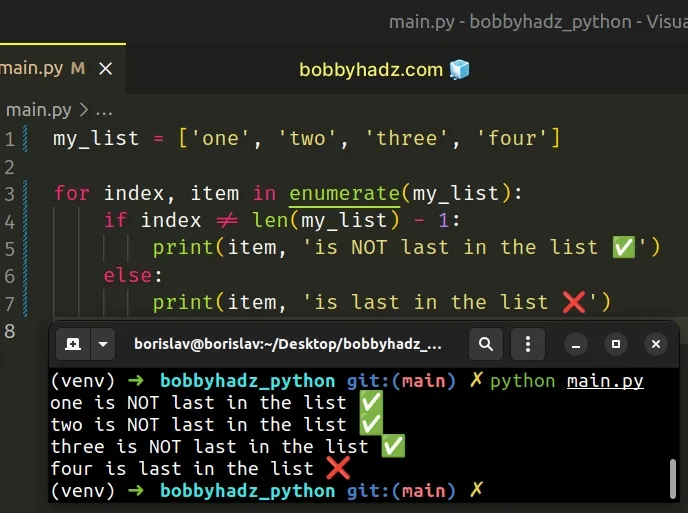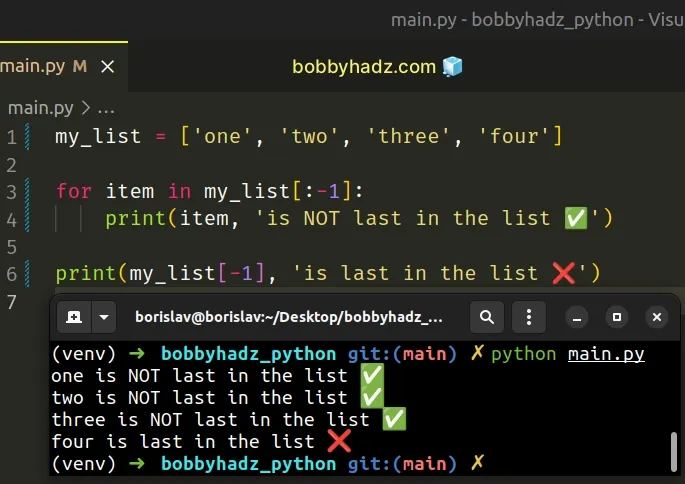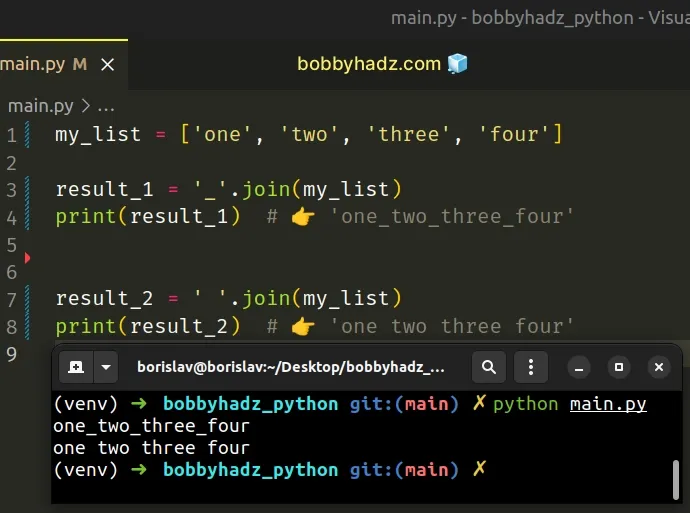Detect the Last item in a List using a for loop in Python
Last updated: Apr 9, 2024
Reading time·4 min

# Table of Contents
- Detect the last item in a list using a for loop in Python
- Checking if the current index is equal to the last index
- Checking if we are on the last iteration of the loop
- Not performing an operation for the last item in the list
- Joining without a separator after the last item
# Detect the last item in a list using a for loop in Python
To detect the last item in a list using a for loop:
- Use the
enumeratefunction to get tuples of the index and the item. - Use a
forloop to iterate over theenumerateobject. - If the current index is equal to the list's length minus
1, then it's the last item in the list.
my_list = ['one', 'two', 'three', 'four'] for index, item in enumerate(my_list): if index != len(my_list) - 1: print(item, 'is NOT last in the list ✅') else: print(item, 'is last in the list ❌')

We used the enumerate() function to get an enumerate object we can iterate
over.
The enumerate function takes an iterable and returns an enumerate object containing tuples where the first element is the index and the second is the item.
my_list = ['one', 'two', 'three', 'four'] # 👇️ [(0, 'one'), (1, 'two'), (2, 'three'), (3, 'four')] print(list(enumerate(my_list)))
We used a for loop to iterate over the enumerate object and on each
iteration, we check if the current index is NOT equal to the last index in the
list.
# Checking if the current index is equal to the last index
If the current index is not equal to the last index in the list, then the element is not the last list item.
my_list = ['one', 'two', 'three', 'four'] for index, item in enumerate(my_list): if index != len(my_list) - 1: print(item, 'is NOT last in the list ✅') else: print(item, 'is last in the list ❌')

0, and the last index is len(my_list) - 1.# Checking if we are on the last iteration of the loop
If you need to check if the element is the last list item, change the not equals (!=) operator to the equals (==) operator.
my_list = ['one', 'two', 'three', 'four'] for index, item in enumerate(my_list): if index == len(my_list) - 1: print(item, 'is last in the list ✅') else: print(item, 'is NOT last in the list ❌')

The example checks if the current index is equal to the last index in the list.
# Not performing an operation for the Last item in the List
If you don't want to perform an operation for the last item in the list, use a list slice that excludes it.
my_list = ['one', 'two', 'three', 'four'] for item in my_list[:-1]: print(item, 'is NOT last in the list ✅') print(my_list[-1], 'is last in the list ❌')

The my_list[:-1] syntax returns a slice of the list that excludes the last
element.
The syntax for list slicing is
my_list[start:stop:step].
0 and goes up to, but not including the last item in the list.Negative indices can be used to count backward, e.g. my_list[-1] returns the
last item in the list and my_list[-2] returns the second-to-last item.
# Joining without a separator after the last item
If you need to join the items in the list with a string separator, but don't
want to add the separator after the last element, use the str.join() method.
my_list = ['one', 'two', 'three', 'four'] result_1 = '_'.join(my_list) print(result_1) # 👉️ 'one_two_three_four' result_2 = ' '.join(my_list) print(result_2) # 👉️ 'one two three four'

The str.join() method takes an iterable as an argument and returns a string which is the concatenation of the strings in the iterable.
TypeError if there are any non-string values in the iterable.If your list contains numbers or other types, convert all of the values to
string before calling join().
my_list = ['one', 1, 'two', 2, 'three', 3] list_of_strings = list(map(str, my_list)) result_1 = '_'.join(list_of_strings) print(result_1) # 👉️ 'one_1_two_2_three_3' result_2 = ' '.join(list_of_strings) print(result_2) # 👉️ 'one 1 two 2 three 3'
The string the method is called on is used as the separator between the elements.
If you don't need a separator and just want to join the iterable's elements into
a string, call the join() method on an empty string.
my_list = ['one', 'two', 'three'] result_1 = ''.join(my_list) print(result_1) # 👉️ 'onetwothree'
# Additional Resources
You can learn more about the related topics by checking out the following tutorials:

